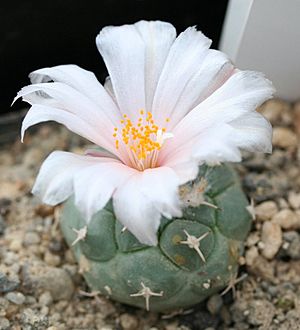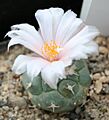Turbinicarpus lophophoroides facts for kids
Quick facts for kids Turbinicarpus lophophoroides |
|
|---|---|
 |
|
| Conservation status | |
| Scientific classification |
The Turbinicarpus lophophoroides is a special kind of plant that belongs to the Cactaceae family, which means it's a type of cactus. This small cactus is found only in Mexico, making it an endemic species. This means it naturally grows nowhere else in the world!
You can find this unique cactus in very dry places. Its natural habitats include warm, dry lowland grasslands and hot deserts. Sadly, this amazing plant is facing some big challenges. Its numbers are shrinking because of people collecting them illegally, its home disappearing, and tiny insects harming it.
Contents
What is Turbinicarpus lophophoroides?
This cactus is part of a group of small, often round cacti. They are known for their interesting shapes and sometimes colorful flowers. The Turbinicarpus lophophoroides is a great example of the many different kinds of plants that live in dry areas.
Where Does This Cactus Live?
Its Home in Mexico
The Turbinicarpus lophophoroides is a true Mexican native. It grows only in certain parts of Mexico, especially in areas that are very dry and sunny. Imagine a place with lots of sunshine and not much rain – that's where this cactus feels at home!
Its favorite places to grow are:
- Dry lowland grasslands: These are flat areas with short grasses and dry soil.
- Hot deserts: Places with very little water and high temperatures.
Why is This Cactus in Danger?
Sadly, the Turbinicarpus lophophoroides is considered a "Near Threatened" species. This means its population is decreasing, and it could become endangered if things don't change. There are a few main reasons why this cactus is in trouble:
Illegal Collecting
One big problem is that people sometimes take these cacti from their natural homes without permission. This is called illegal collecting. When too many plants are taken from the wild, it makes it harder for the species to survive and reproduce.
Habitat Loss
Another major threat is habitat loss. This happens when the places where the cactus naturally grows are changed or destroyed. For example, land might be cleared for farming, new buildings, or roads. When its habitat disappears, the cactus has nowhere to live.
Insect Problems
Tiny insects can also be a problem for the Turbinicarpus lophophoroides. Sometimes, these insects act as parasites, meaning they live on or in the cactus and harm it. A large number of these pests can weaken the plants and even kill them.
Protecting the Turbinicarpus lophophoroides
Because this cactus is so special and in danger, people are working to protect it. Laws are in place to stop illegal collecting. Also, efforts are being made to protect its natural habitats so that this unique plant can continue to thrive in the wild for many years to come.
See also
In Spanish: Biznaga peyotito para niños
Images for kids



